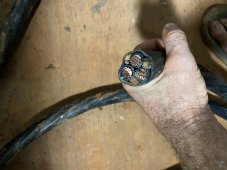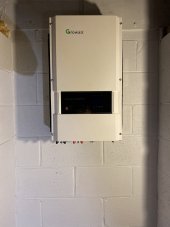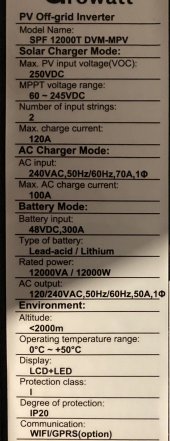You are using an out of date browser. It may not display this or other websites correctly.
You should upgrade or use an alternative browser.
You should upgrade or use an alternative browser.
Growatt 12k unboxing
- Thread starter Jgb3
- Start date
MisterSandals
Participation Medalist
Not much you can do other than mount it and make wires without a battery.Any tips or tricks would be great but it will be awhile before my battery arrives
Have you planned out your array? Breakers and fuses for your loads?
Yeah ordered some spd stuff shut offs and a few other odds and ends. Got super strut from homedepot yesterday for mounting the panels and working on how to properly ground and bond everything. I also bought a generator to charge when needed so that all needs wired. It’s definitely been a learning process
So you can put a 12000 watt array into this thing and have a complete system? And it will be string wired all the way, and I assume 48 volt? What capacity of batteries will you have? And are you going to tie it to the grid? What have you got for panels, and can I ask the price?
It’s a 12000 watt inverter. It says it can handle about 7000 watts of panels. I have 32 lifepo4 280ah cells on the way and no not grid tied. For panels I have 24 335 watt qcells I found online used for $115 eachSo you can put a 12000 watt array into this thing and have a complete system? And it will be string wired all the way, and I assume 48 volt? What capacity of batteries will you have? And are you going to tie it to the grid? What have you got for panels, and can I ask the price?
Under $3k can’t remember exactly what it was with shipping and it weighs like 165 lbs I think?So how much did the 12K Growatt invertor cost. What does that weigh?
I am very curious, what else can you tell me about the panels? I will hope someone will weight in on the 12K invertor limited to 7000 watts. The price seems excellent on the 335 watt panels. Thanks for sharing all of thisIt’s a 12000 watt inverter. It says it can handle about 7000 watts of panels. I have 32 lifepo4 280ah cells on the way and no not grid tied. For panels I have 24 335 watt qcells I found online used for $115 each
If you are interested in the panels I can try to get you the guys contact info he said he would ship in the US he’s around the NC SC border. Also you can pull 12000 watts from the inverter and it has a 36000 watt peak it’s the mppt that is limited to around 7000 watts of panels. I am over paneling a little and will have 8040 watts worthI am very curious, what else can you tell me about the panels? I will hope someone will weight in on the 12K invertor limited to 7000 watts. The price seems excellent on the 335 watt panels. Thanks for sharing all of this
Fascinating, I would love to hear about them, is that where you got the Growatt invertor also? I am off to bed so I will not be responding until morning sometime. Thanks for the info and help. I do hope others weigh in on your interests in tips for your system. I am also interested in the Home Depot mounting channels, and how they work out for you.If you are interested in the panels I can try to get you the guys contact info he said he would ship in the US he’s around the NC SC border. Also you can pull 12000 watts from the inverter and it has a 36000 watt peak it’s the mppt that is limited to around 7000 watts of panels. I am over paneling a little and will have 8040 watts worth
!
MisterSandals
Participation Medalist
Have you looked at the max input voltage from your array and figured out how to arrange your array to meet this limit? You will likely need to do a combination of series and parallel to meet the max input voltage limit.I am over paneling a little and will have 8040 watts worth
19 strand works very well for AC, NOT too good for DC, really you should be using very fine strand, 1050 or so, like welding cable......really tough to explain from an engineering standpoint “skin effect” DC is more about surface area where AC is more about square area....thus very fine strand will conduct far more than 19 strandView attachment 55605
That should work for some battery cables
Not according to this website19 strand works very well for AC, NOT too good for DC, really you should be using very fine strand, 1050 or so, like welding cable......really tough to explain from an engineering standpoint “skin effect” DC is more about surface area where AC is more about square area....thus very fine strand will conduct far more than 19 strand

Cause the inverter is 12000 wattsI don't know what to tell you on that, others will be able to help. I am still a bit concerned about only being able to hook 7000 watts to it. I have seen the explanation, but wonder why they call it a 12,000 watt unit?
So I can plug in a 12000 watt toaster (lol) and it will run it
Daveyclimber
New Member
- Joined
- May 2, 2021
- Messages
- 65
Can you wire in a separate charge controller to control additional panels?
stienman
Mostly Harmless
- Joined
- Jan 6, 2021
- Messages
- 476
The growatt off grid inverters are better thought of as three in one devices. I have their 6kw unit and ran into the same issue before I dug in and understood their intent.I don't know what to tell you on that, others will be able to help. I am still a bit concerned about only being able to hook 7000 watts to it. I have seen the explanation, but wonder why they call it a 12,000 watt unit?
They include, in one box:
AC battery charger
MPPT battery charger
Inverter
The unit’s name refers to the inverter capacity, and each part has its own capacity limit.
For the 6kw unit here are the specifications:
AC charger: 48V @ 60A (~3kW)
MPPT charger: 48V @ 80A (~4kW)
Inverter: 3kW per leg of 240VAC split single phase for 6kW total.
Note that the newer models have a 250v dc solar input, my model and older models are limited to 150vdc. Check carefully if you’re considering one.
Almost all inverters are rated or advertised according to the maximum inverter output, regardless of the other capacities of the unit.
The DC bus can easily be charged with other AC or MPPT chargers external to the inverter, so it’s not a problem to supplement the unit’s capacity if that’s a limitation for your application.
Keep in mind that when an inverter is selected for a house, you specify the maximum current the inverter is likely to see - these can handle 6kw with no sweat, but if you’re running 5kw base load and turn on the microwave the inverter is going to shut down after a few seconds.
You wouldn’t specify a 6kW solar array for a household that only uses 10-20kwh a day, and if your house uses 24kwh a day you need more than a 1kw inverter because your loads vary.
So a 6kw inverter is ok for small off grid applications, or for careful users who don’t mind not running the clothes washers when they need the oven, for instance.
The smaller rated solar array is, therefore, sufficient for a 6kW inverter. You can add another MPPT charger, but if your base load is close to the 6kw inverter capacity then you really need a larger inverter unless you’re in a specialized situation.
In my case I have a 6kW off grid with 5.6kw of solar attached and a 48v 75AH battery, as well as a 6kw grid tie inverter with 2.2k of solar attached. This way I can use the full power of my array during the day if needed without pushing it all through the DC bus and the tiny battery.
Similar threads
- Replies
- 3
- Views
- 295






